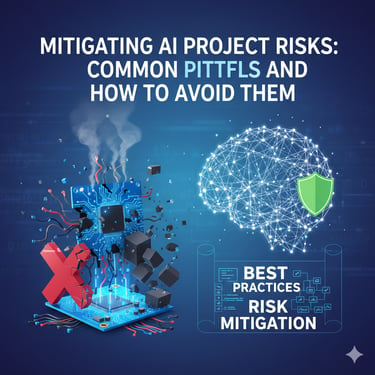Mitigating AI Project Risks: Common Pitfalls and How to Avoid Them
10/14/20253 min read


AI projects are now central to business competitiveness, offering automation, improved decision-making, and new revenue streams. However, despite major investments, most AI initiatives fail to scale or deliver promised value due to underestimated risks.
Common pitfalls include poor data quality, ethical issues, skill gaps, and challenges in moving from prototypes to production. Even advanced algorithms cannot compensate for neglected foundational risks.
This guide highlights the core challenges that derail AI projects and offers practical strategies to mitigate risks at every stage—from implementing data governance and building cross-functional teams to defining ROI metrics and ensuring responsible AI practices. The aim is simple: help you avoid common obstacles and improve your chances of achieving successful, business-aligned AI outcomes.
1. Understanding Key Risks in AI Projects
AI project risks are multifaceted and can escalate quickly if not addressed early:
1.1 Data Quality Issues
AI models are only as good as their data. Incomplete, inconsistent, outdated, or biased data leads to unreliable outputs and perpetuates discrimination. Neglecting data preparation often results in costly failures.
1.2 Ethical Concerns
AI systems can reinforce historical biases or violate privacy when built on inappropriate data or without adequate safeguards. Legal and reputational consequences can halt projects unexpectedly.
1.3 Scalability Challenges
A working pilot may collapse under real-world volumes due to infrastructure limits, poor integration with existing systems, or lack of scalable MLOps processes.
1.4 Other Types of Risks
Talent shortages, security vulnerabilities, unclear ROI metrics, and user resistance also threaten success. Proactive risk frameworks are essential throughout the project lifecycle.
2. Ensuring Data Readiness and Governance
Data quality is the foundation of any AI initiative. Poor data causes unreliable predictions and legal liabilities. Early investment in profiling, cleaning, feature engineering, and validation is critical.
Governance frameworks define clear ownership, access controls, versioning, audit trails, and compliance processes—essential for privacy regulations like GDPR or CCPA.
3. Defining Clear Objectives & Measuring ROI
Vague goals cause scope creep and misalignment. Set specific objectives (e.g., "reduce response time by 40% in six months") with measurable targets. Track both quantitative (cost savings, efficiency gains) and qualitative (decision speed, employee satisfaction) metrics. Establish baselines before deployment for accurate ROI assessment.
4. Building Cross-Functional Teams
Technical brilliance must be paired with business understanding. Successful teams include:
● Data scientists/ML engineers
● Software engineers
● Domain experts
● Compliance/legal staff
● IT security professionals
● Product managers
Foster T-shaped skills for better collaboration; ensure regular communication between technical teams and business stakeholders; hire hybrid professionals with both domain knowledge and data literacy.
5. Mitigating Ethical Risks Through Responsible Design
Unaddressed biases risk discrimination; privacy lapses cause legal trouble; lack of consent undermines trust.
Embed fairness assessments throughout development; establish governance policies for acceptable use cases; form diverse ethics committees; maintain human oversight for high-impact decisions; document all processes for accountability.
6. Overcoming Technical Challenges at Scale
Moving from prototype to production reveals new technical hurdles:
● Infrastructure limitations: Plan for scalable architectures early.
● Integration complexities: Identify integration points upfront.
● Security vulnerabilities: Apply strong security measures as you scale.
● Model drift: Monitor performance continuously; retrain when needed.
7. Ensuring Accountability Through Explainable Models
Trust requires explainability—not just technical transparency but understandable reasoning for all stakeholders (business leaders, compliance officers, end-users). Use techniques like LIME and SHAP for interpretability; document model building processes and decisions; maintain audit trails for regulatory compliance (e.g., GDPR).
Best Practices Across the AI Lifecycle
● Start with a clear strategy document defining measurable goals.
● Conduct risk assessments covering data quality, security, ethics.
● Build your data foundation early.
● Assemble cross-functional teams from day one.
● Design for scale from the prototype phase.
● Implement continuous monitoring for performance/fairness.
● Engage stakeholders regularly with transparent updates.
● Document decisions thoroughly; maintain audit trails.
● Prioritize user training/change management for adoption.
By following these disciplined practices at every stage—from planning to production—you can navigate common pitfalls and maximize the likelihood of successful AI outcomes aligned with your organization’s goals.
Location
Address: Workshaala Vista, N R Tower, 2nd Floor, 17th Cross Road, 19th Main Rd, Sector 4, HSR Layout, Bengaluru, Karnataka 560102
Contacts

Copyright © 2025 by Oliware Technologies Pvt Ltd.
